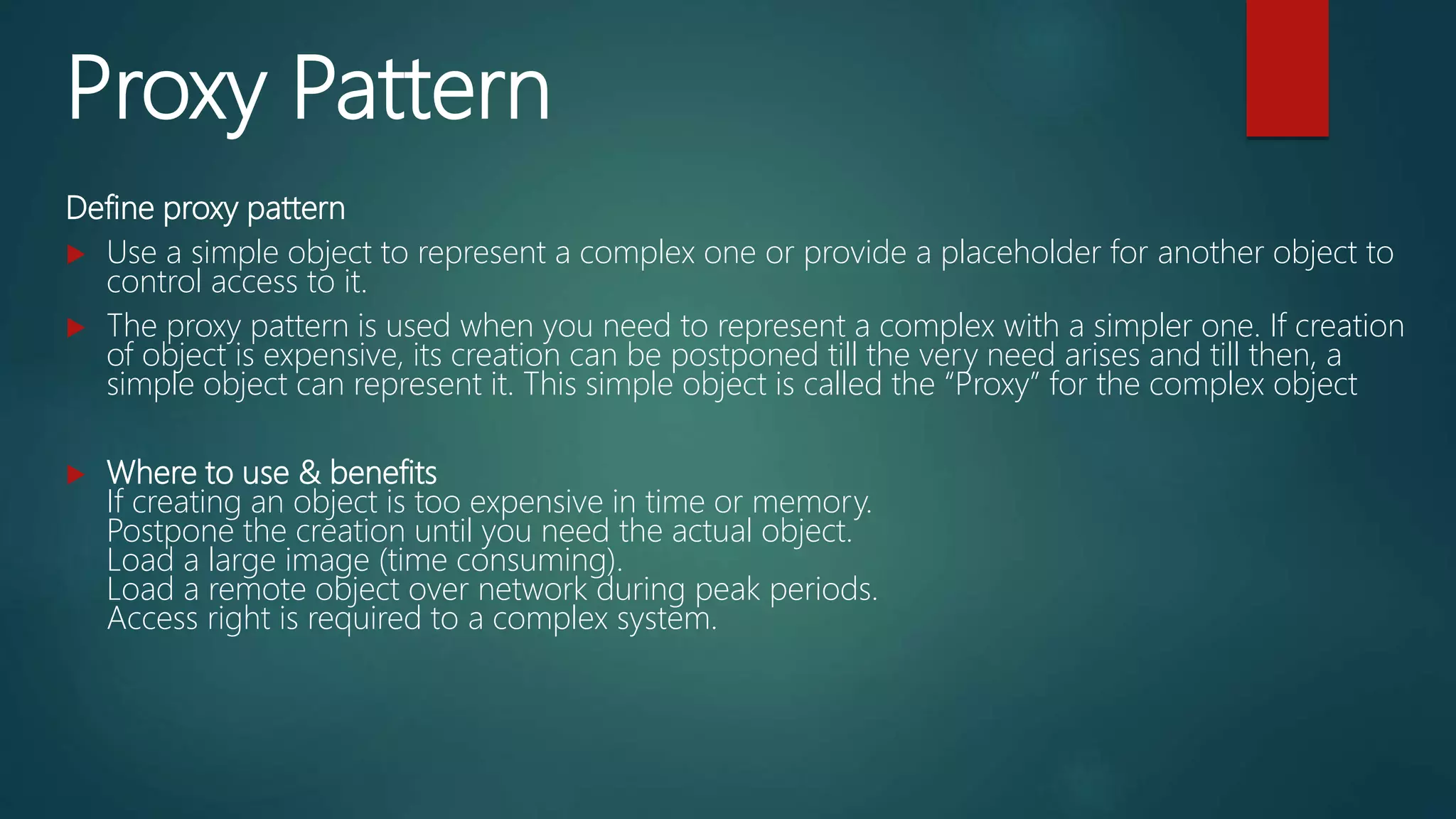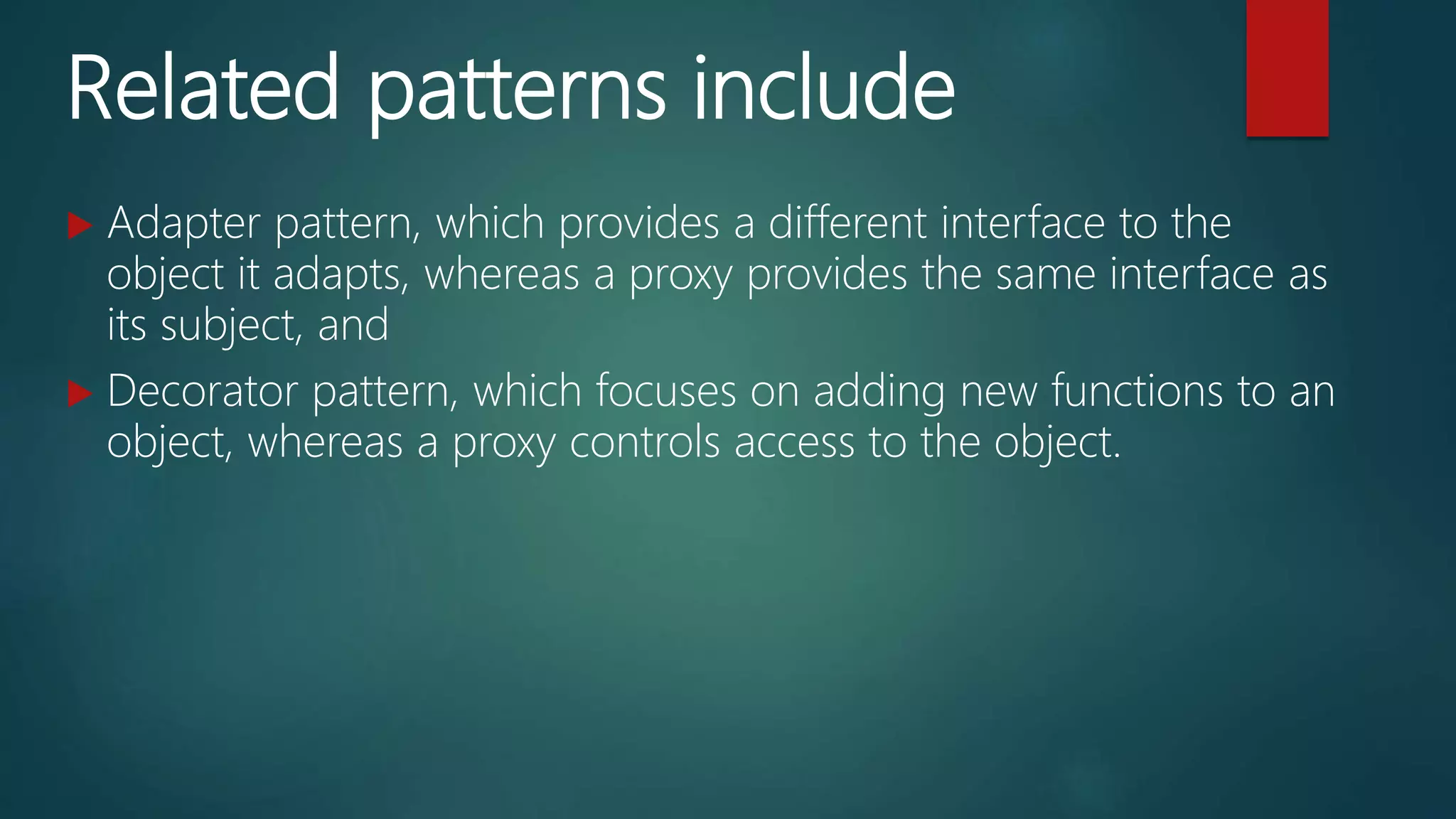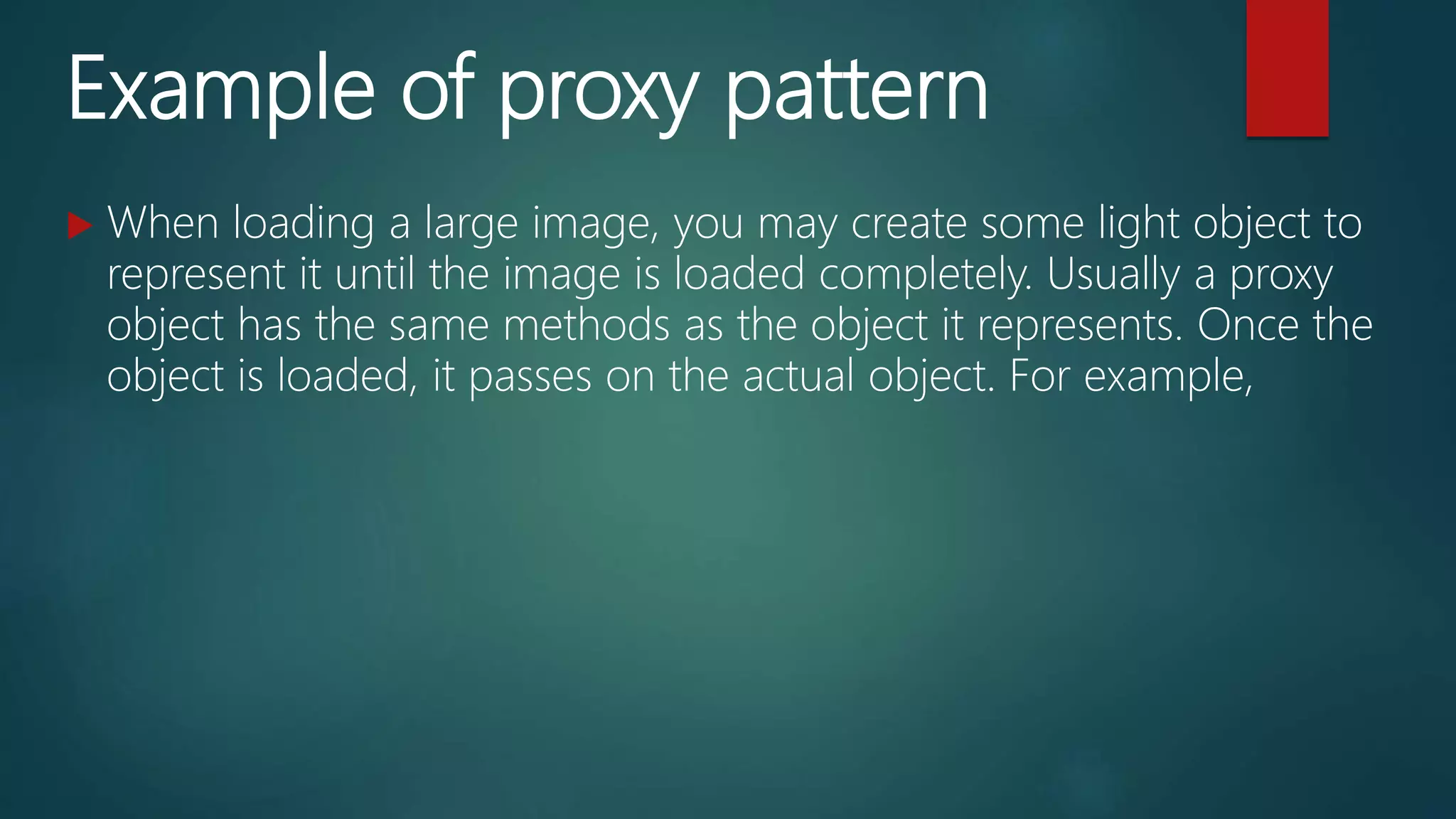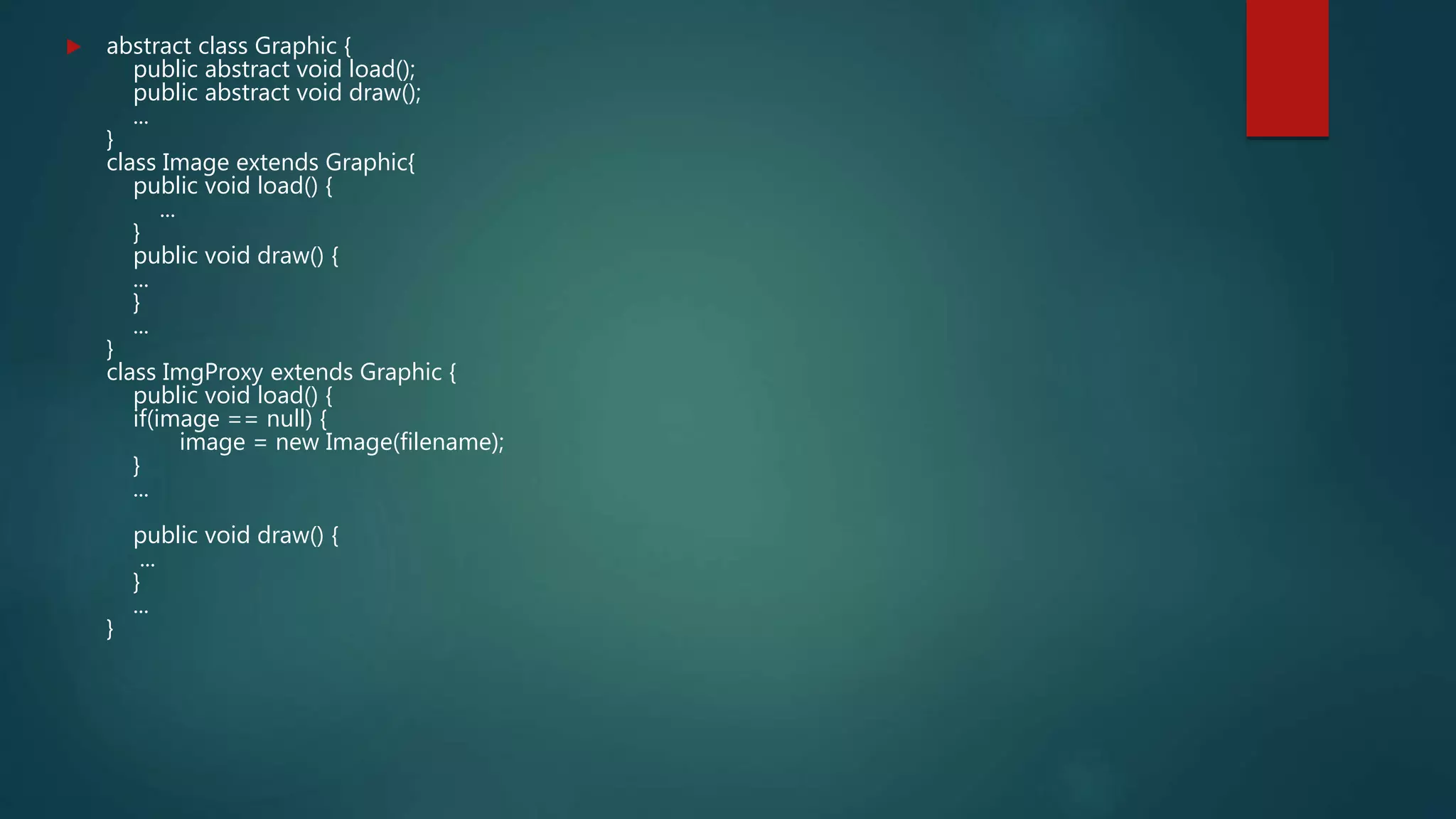This document discusses three design patterns: Adapter, Bridge, and Composite.
The Adapter pattern allows classes with incompatible interfaces to work together by wrapping its interface into a compatible one. The Bridge pattern decouples an abstraction from its implementation, allowing them to vary independently. The Composite pattern allows treating individual objects and compositions of objects uniformly.
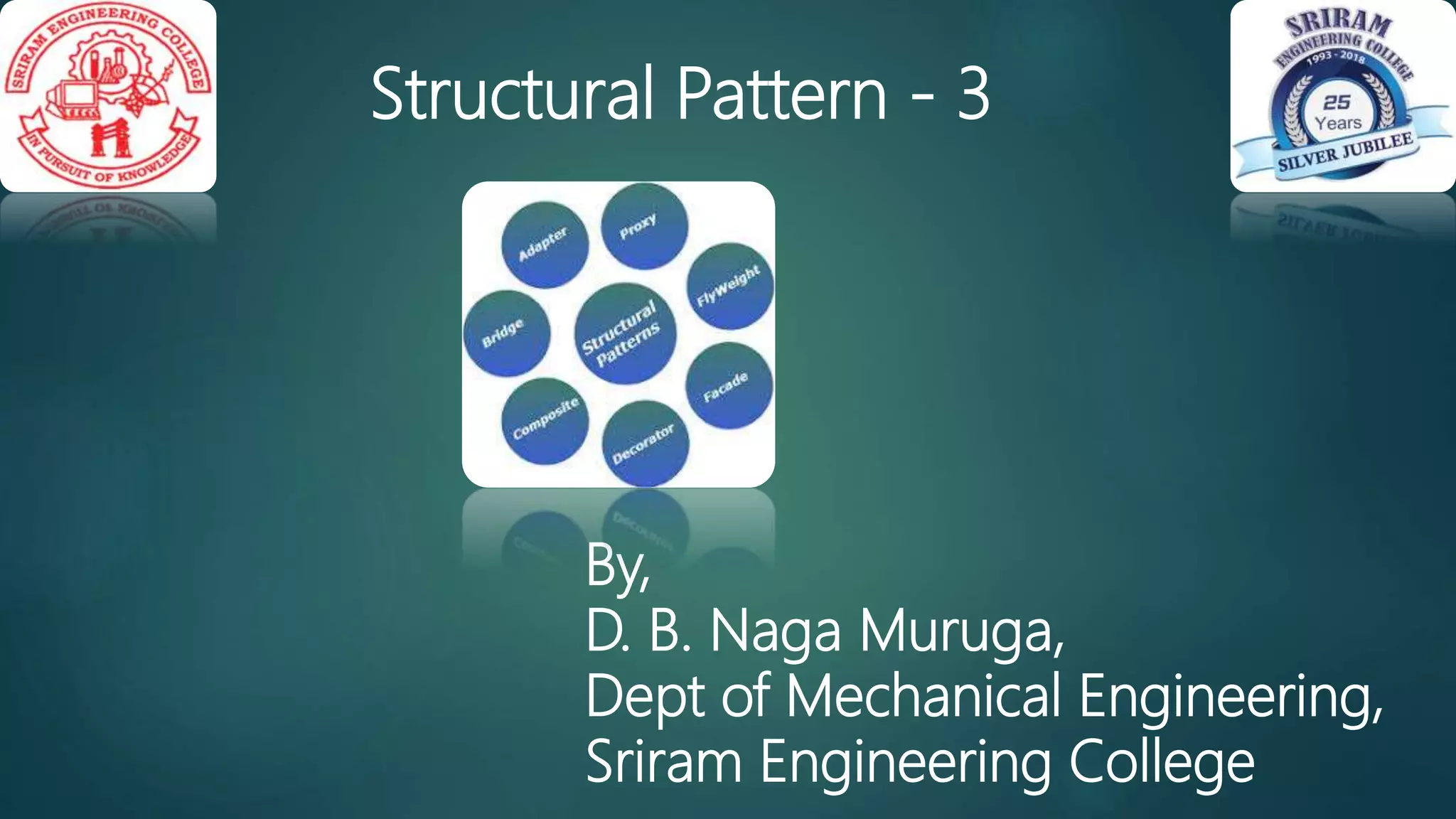
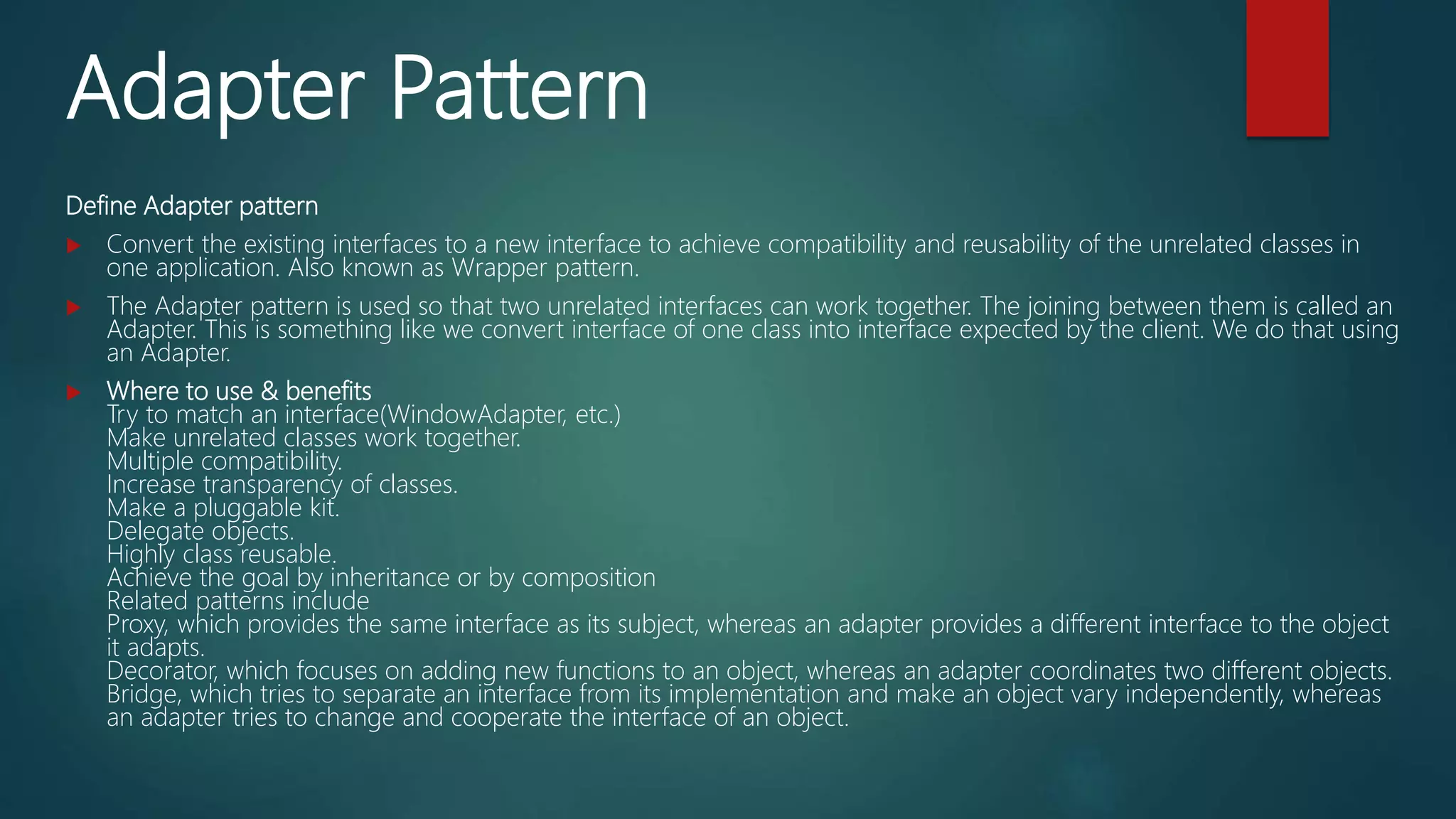
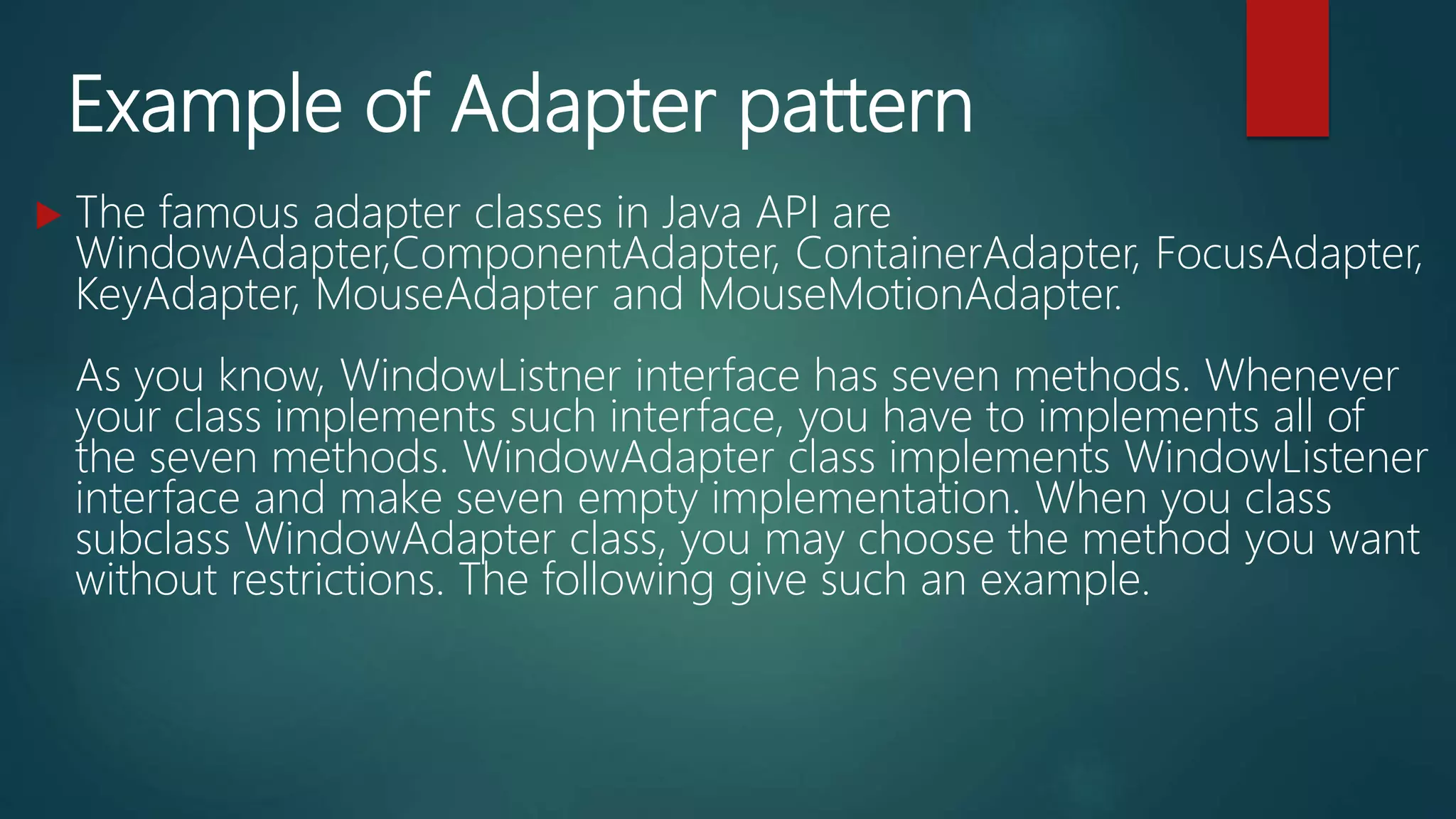
![ public interface Windowlistener {
public void windowClosed(WindowEvent e);
public void windowOpened(WindowEvent e);
public void windowIconified(WindowEvent e);
public void windowDeiconified(WindowEvent e);
public void windowActivated(WindowEvent e);
public void windowDeactivated(WindowEvent e);
public void windowClosing(WindowEvent e);
}
public class WindowAdapter implements WindowListner{
public void windowClosed(WindowEvent e){}
public void windowOpened(WindowEvent e){}
public void windowIconified(WindowEvent e){}
public void windowDeiconified(WindowEvent e){}
public void windowActivated(WindowEvent e){}
public void windowDeactivated(WindowEvent e){}
public void windowClosing(WindowEvent e){}
}
Here is a test program
import javax.swing.*;
import java.awt.event.*;
class Test extends JFrame {
public Test () {
setSize(200,200);
setVisible(true);
addWindowListener(new Closer());
}
public static void main(String[] args) {
new Test();
}
class Closer extends WindowAdapter {
public void windowClosing(WindowEvent e) {
System.exit(0);
}
}
}
To reuse classes and make new class compatible with existing ones. For
example, A clean system is already designed, you want to add more job in,
the Extra interface uses adapter pattern to plug in the existing system.
interface Clean {
public void makeClean();
}
class Office implements Clean{
public void makeClean() {
System.out.println("Clean Office");
}
}
class Workshop implements Clean{
public void makeClean() {
System.out.println("Clean Workshop");
}
}
interface Extra extends Clean{
public void takeCare();
}
class Facility implements Extra{
public void makeClean() {
System.out.println("Clean Facility");
}
public void takeCare() {
System.out.println("Care has been taken");
}
}
In order to reuse Workshop and Office classes,
we create an adapter interface Extra and
add new job takeCare in the system.
class Test {
static void Jobs (Extra job) {
if (job instanceof Clean)
((Clean)job).makeClean();
if ((Extra)job instanceof Extra)
((Extra)job).takeCare();
}
public static void main(String[] args) {
Extra e = new Facility();
Jobs(e);
Clean c1 = new Office();
Clean c2 = new Workshop();
c1.makeClean();
c2.makeClean();
e.makeClean();
}
}
Output :
Clean Facility
Care has been taken
Clean Office
Clean Workshop
Clean Facility
By composition, we can achieve adapter pattern. It is also called wrapper. For
example, a Data class has already been designed and well tested. You want to
adapt such class to your system. You may declare it as a variable and wrapper
or embed it into your class.
//well-tested class
class Data {
public void add(Info){}
public void delete(Info) {}
public void modify(Info){}
//...
}
//Use Data class in your own class
class AdaptData {
Data data;
public void add(Info i) {
data.add(i);
//more job
}
public void delete(Info i) {
data.delete(i);
//more job
}
public void modify(Info i) {
data.modify(i);
//more job
}
//more stuff here
//...
}](https://image.slidesharecdn.com/structuralpattern3-191124065008/75/Structural-pattern-3-4-2048.jpg)
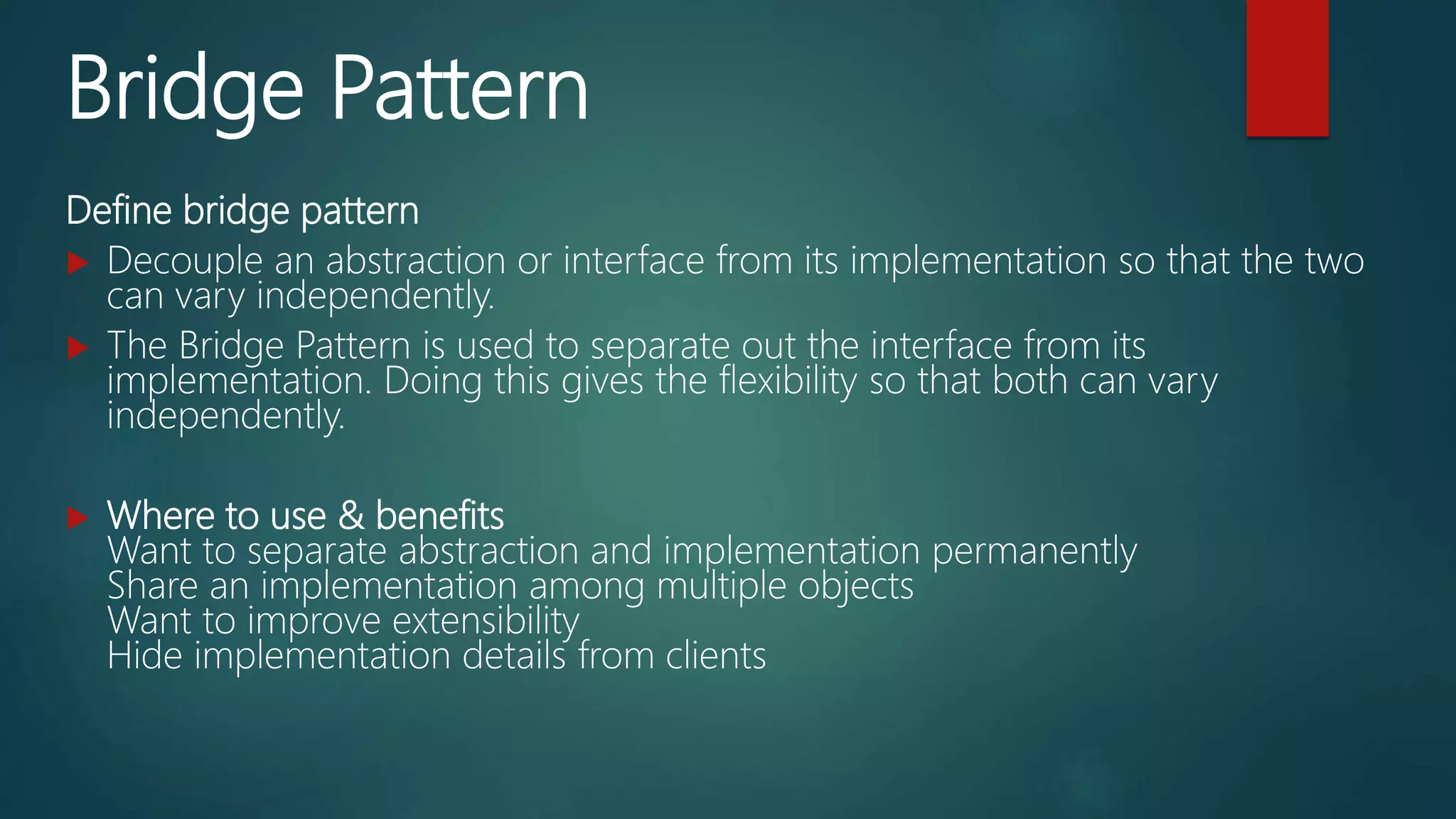
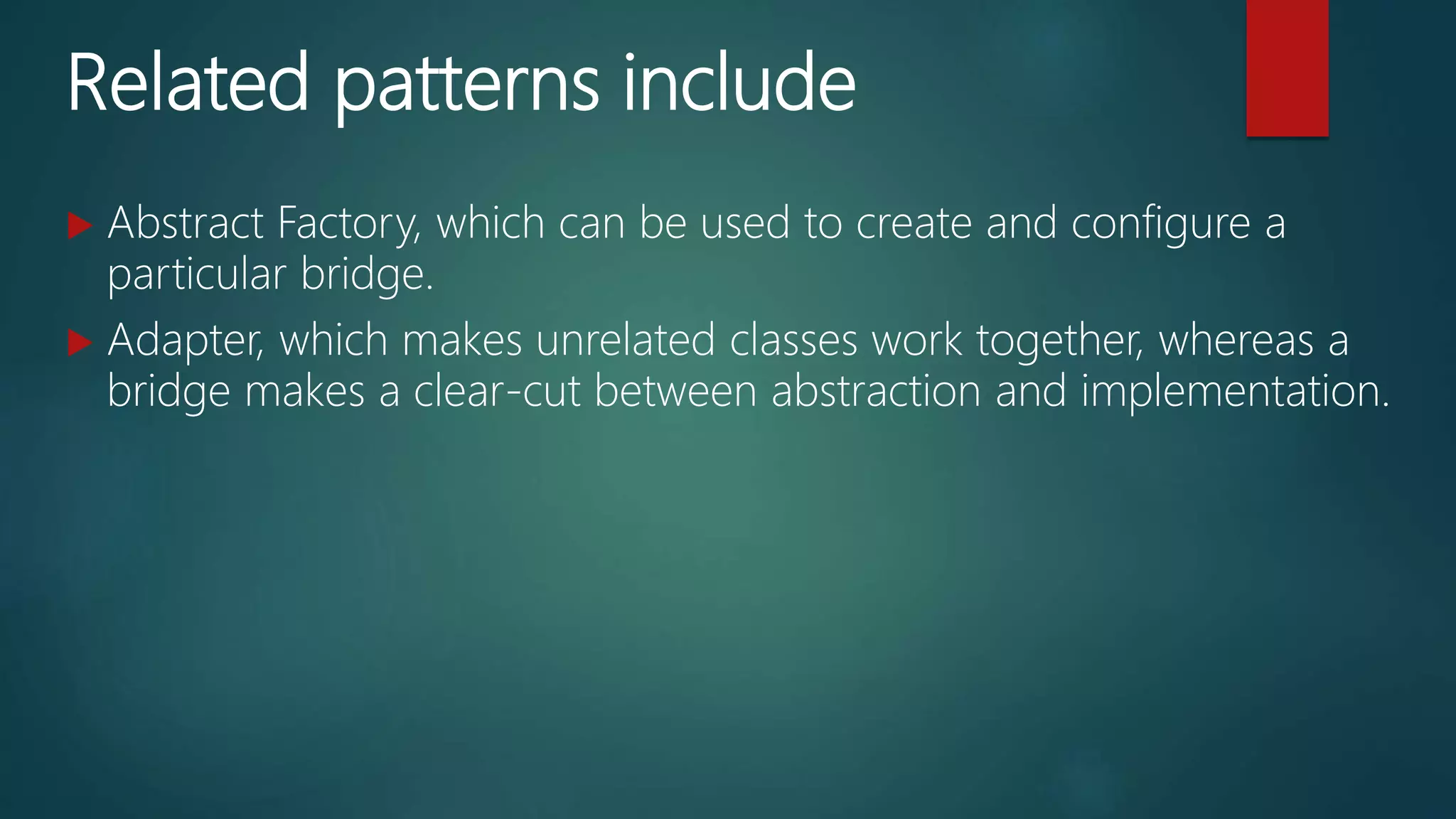
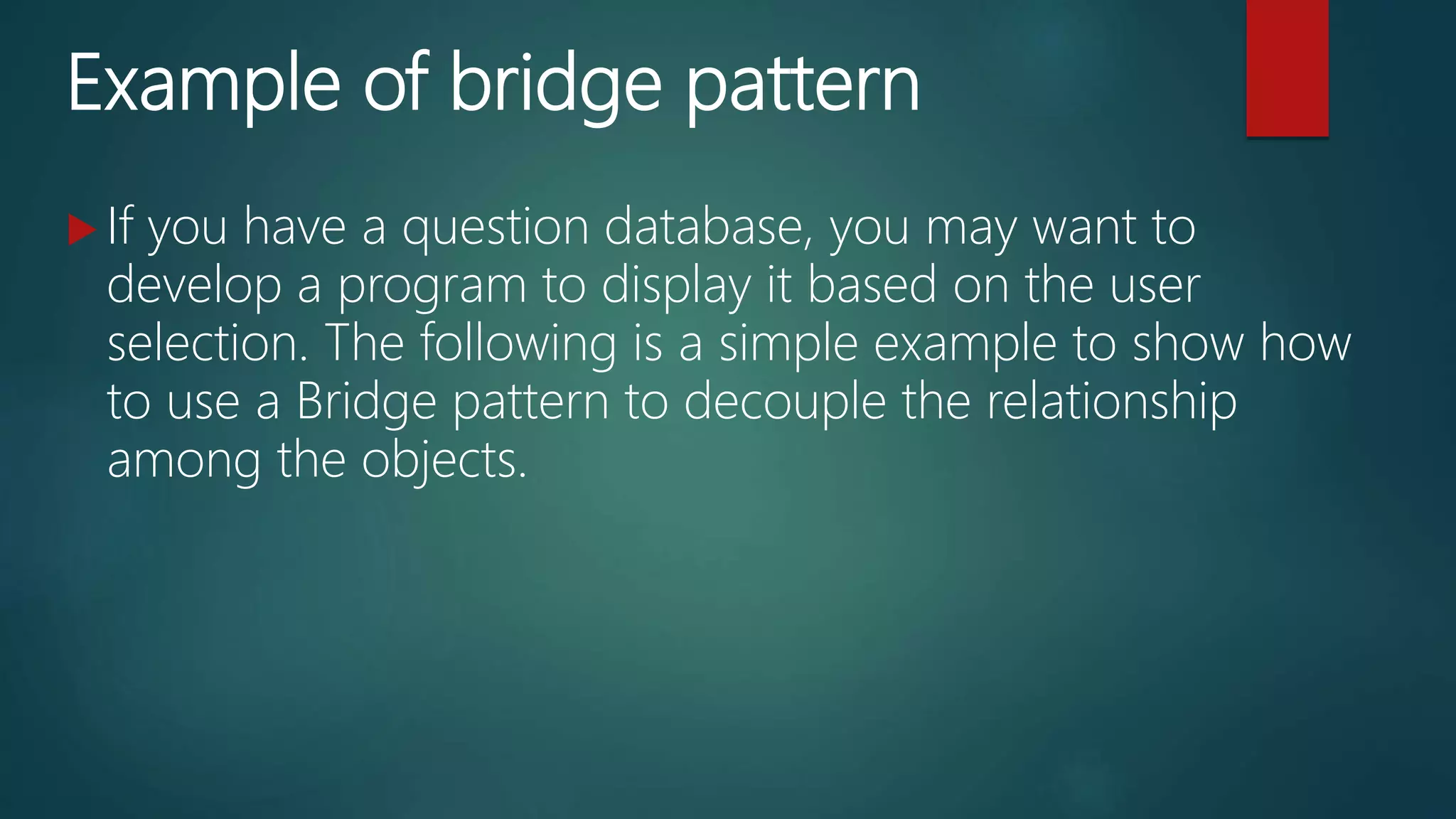
![ import java.util.*;
//abstraction
interface Question {
public void nextQuestion();
public void priorQuestion();
public void newQuestion(String q);
public void deleteQuestion(String q);
public void displayQuestion();
public void displayAllQuestions();
}
//implementation
class QuestionManager {
protected Question questDB; //instantiate it later
public String catalog;
public QuestionManager(String catalog) {
this.catalog = catalog;
}
public void next() {
questDB.nextQuestion();
}
public void prior() {
questDB.priorQuestion();
}
public void newOne(String quest) {
questDB.newQuestion(quest);
}
public void delete(String quest) {
questDB.deleteQuestion(quest);
}
public void display() {
questDB.displayQuestion();
}
public void displayAll() {
System.out.println("Question Catalog: " + catalog);
questDB.displayAllQuestions();
}
}
//further implementation
class QuestionFormat extends QuestionManager {
public QuestionFormat(String catalog){
super(catalog);
}
public void displayAll() {
System.out.println("n~~~~~~~~~~~~~~~~~~~~~~~~");
super.displayAll();
System.out.println("~~~~~~~~~~~~~~~~~~~~~~~~");
}
}
//decoupled implementation
class JavaQuestions implements Question {
private List questions = new ArrayList();
private int current = 0;
public JavaQuestions() {
//load from a database and fill in the container
questions.add("What is Java? ");
questions.add("What is an interface? ");
questions.add("What is cross-platform? ");
questions.add("What is UFT-8? ");
questions.add("What is abstract? ");
questions.add("What is Thread? ");
questions.add("What is multi-threading? ");
}
public void nextQuestion() {
if( current <= questions.size() - 1 )
current++;
}
public void priorQuestion() {
if( current > 0 )
current--;
}
public void newQuestion(String quest) {
questions.add(quest);
}
public void deleteQuestion(String quest) {
questions.remove(quest);
}
public void displayQuestion() {
System.out.println( questions.get(current) );
}
public void displayAllQuestions() {
for (String quest : questions) {
System.out.println(quest);
}
}
}
class TestBridge {
public static void main(String[] args) {
QuestionFormat questions = new QuestionFormat("Java Language");
questions.questDB = new JavaQuestions();//can be hooked up with other
question class
//questions.questDB = new CsharpQuestions();
//questions.questDB = new CplusplusQuestions();
questions.display();
questions.next();
questions.newOne("What is object? ");
questions.newOne("What is reference type?");
questions.displayAll();
}
}](https://image.slidesharecdn.com/structuralpattern3-191124065008/75/Structural-pattern-3-8-2048.jpg)
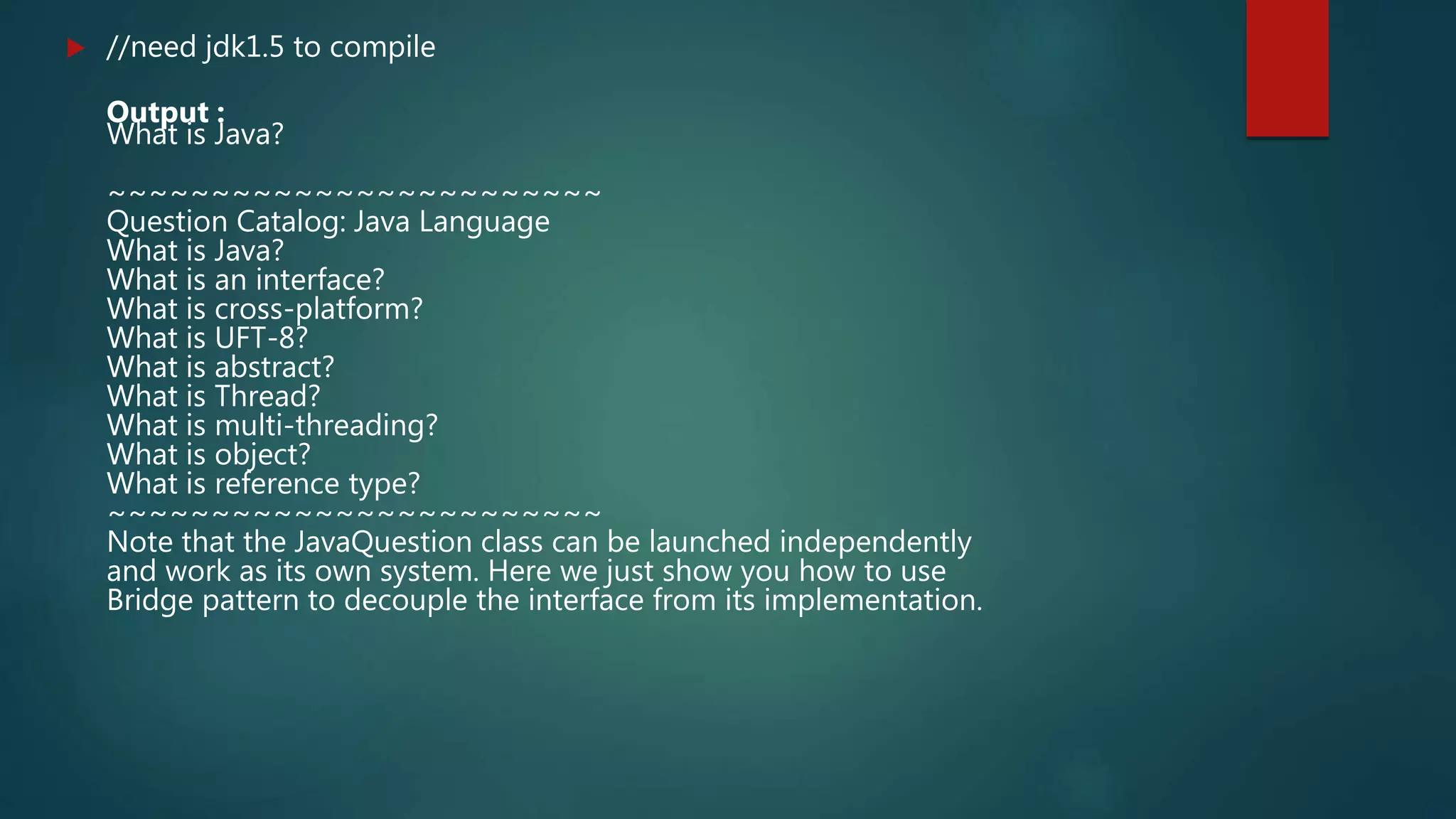
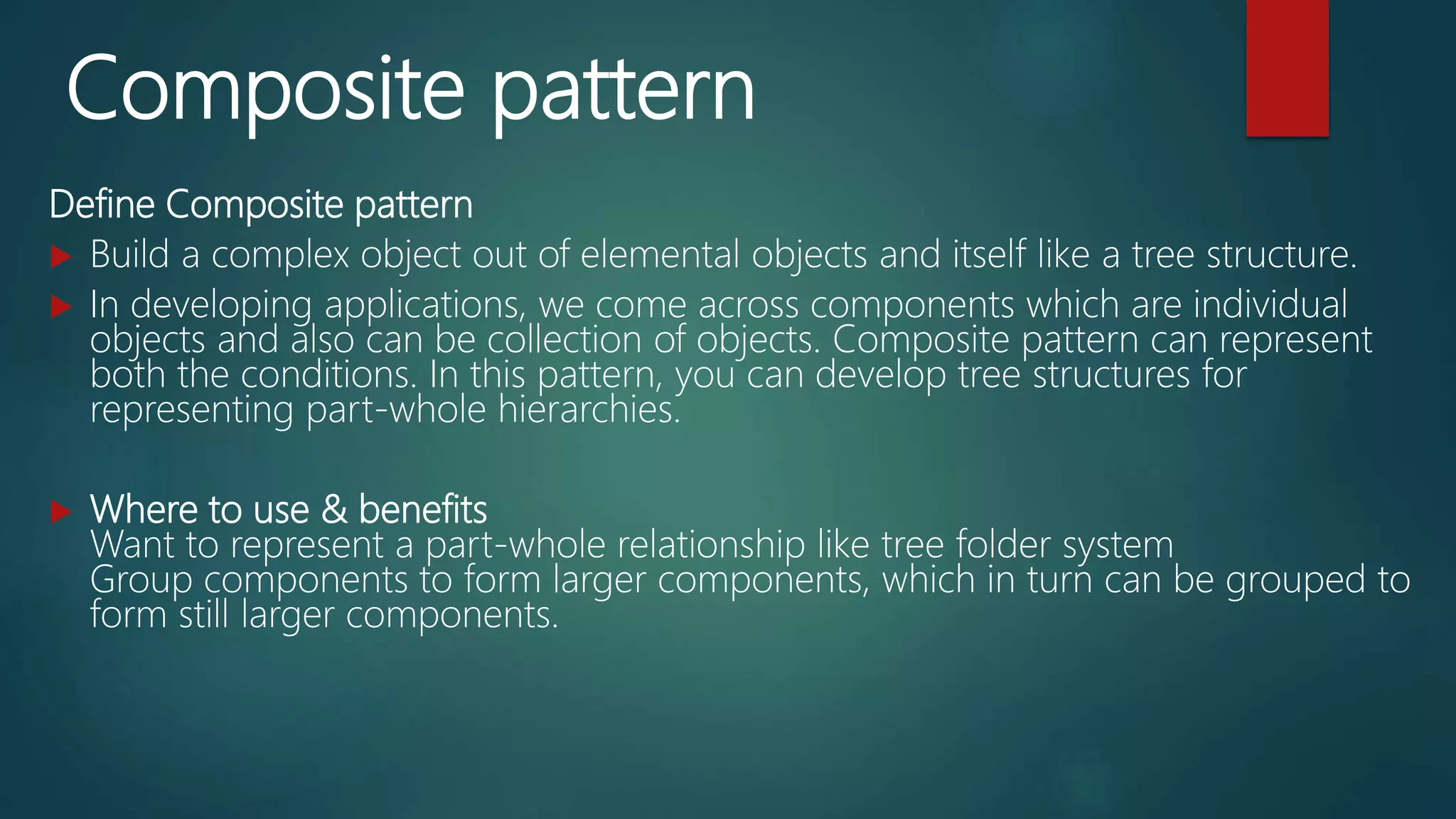
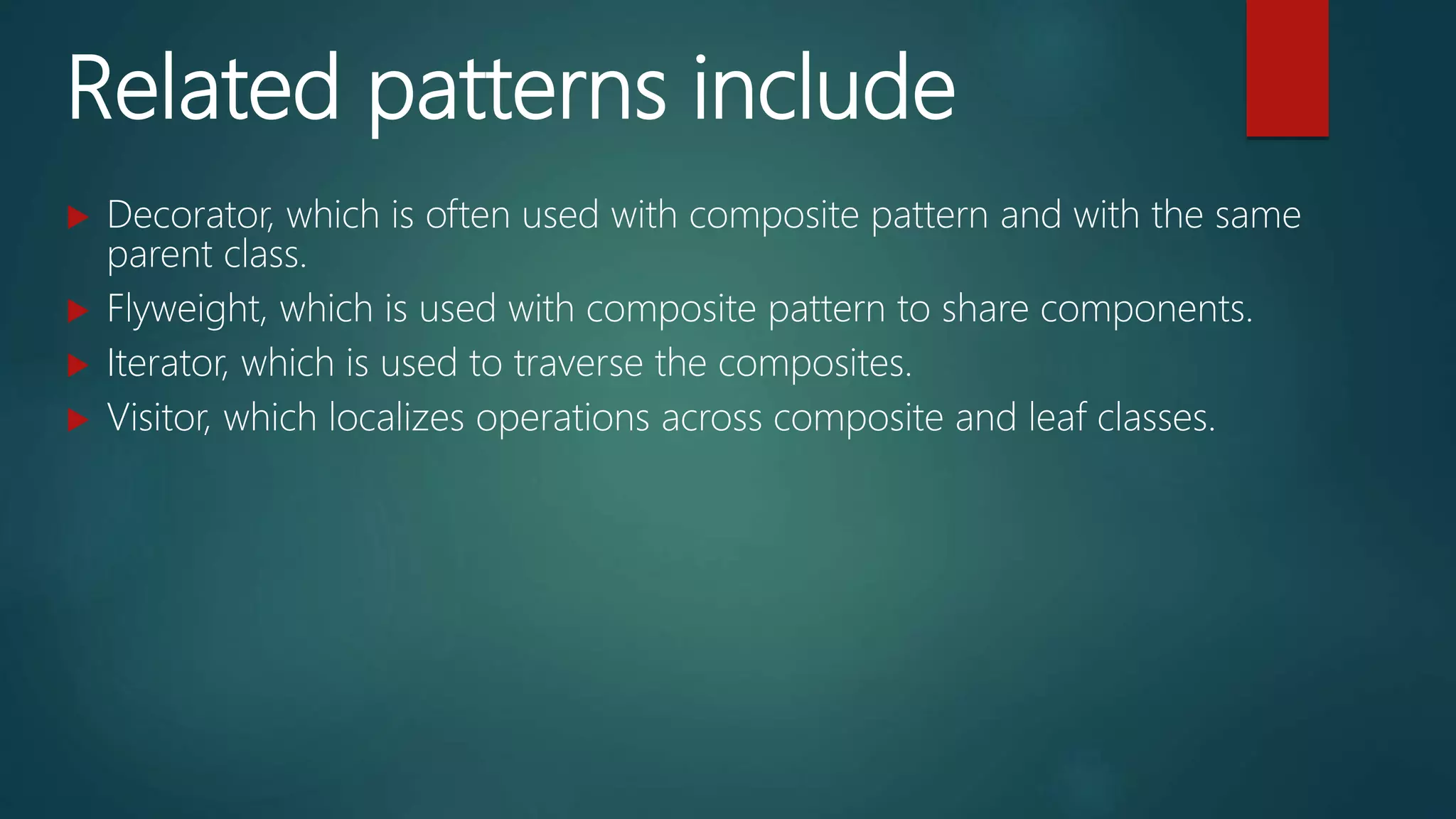
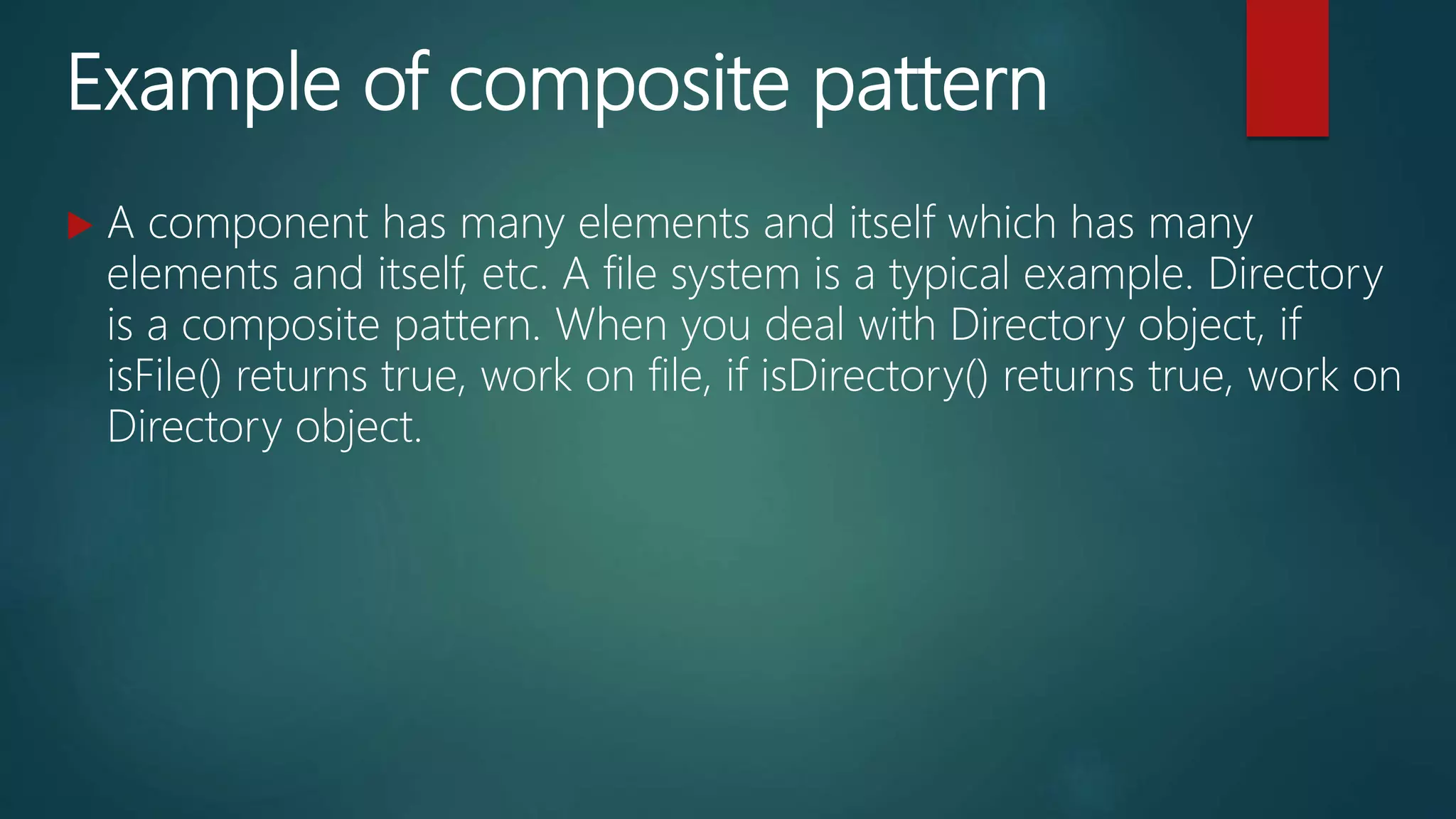
![class Directory {
Directory dir;
File[] f;
...
boolean isDirectory() {
return f == null;
}
boolean isFile() {
return f != null;
}
File getFile(int i) {
if (isFile())
return f[i];
return null'
}
Directory getDirectory() {
if (isDirectory())
return dir;
return null;
}
....
}
For example, General Manager may have several employees and some of
employees are Managers which have several employees. To illustrate such issue, we
design a simple Manager class.
class Employee {
String name;
double salary;
Employee(String n, double s){
name = n;
salary = s;
}
String getName() {
return name;
}
double getSalary() {
return salary;
}
public String toString() {
return "Employee " + name;
}
}
class Manager {
Manager mgr;
Employee[] ely;
String dept;
Manager(Manager mgr,Employee[] e, String d ) {
this(e, d);
this.mgr = mgr;
}
Manager(Employee[] e, String d) {
ely = e;
dept =d;
}
String getDept() {
return dept;
}
Manager getManager() {
return mgr;
}
Employee[] getEmployee() {
return ely;
}
public String toString() {
return dept + " manager";
}
}
class Test {
public static void main(String[] args) {
Employee[] e1 = {new Employee("Aaron", 50),
new Employee("Betty", 60)};
Manager m1 = new Manager(e1, "Accounting");
Employee[] e2 = {new Employee("Cathy", 70),
new Employee("Dan", 80),
new Employee("Eliz", 90)};
Manager m2 = new Manager(m1, e2, "Production");
System.out.println(m2);
Employee[] emp = m2.getEmployee();
if (emp != null)
for (int k = 0; k < emp.length; k++)
System.out.println(" "+emp[k]+" Salary: $"+
emp[k].getSalary());
Manager m = m2.getManager();
System.out.println(" " + m);
if (m!= null) {
Employee[] emps = m.getEmployee();
if (emps != null)
for (int k = 0; k < emps.length; k++)
System.out.println(" " + emps[k]+" Salary: $"+
emps[k].getSalary());
}
}
}
Output :
Production manager
Employee Cathy Salary: $70.0
Employee Dan Salary: $80.0
Employee Eliz Salary: $90.0
Accounting manager
Employee Aaron Salary: $50.0
Employee Betty Salary: $60.0](https://image.slidesharecdn.com/structuralpattern3-191124065008/75/Structural-pattern-3-13-2048.jpg)
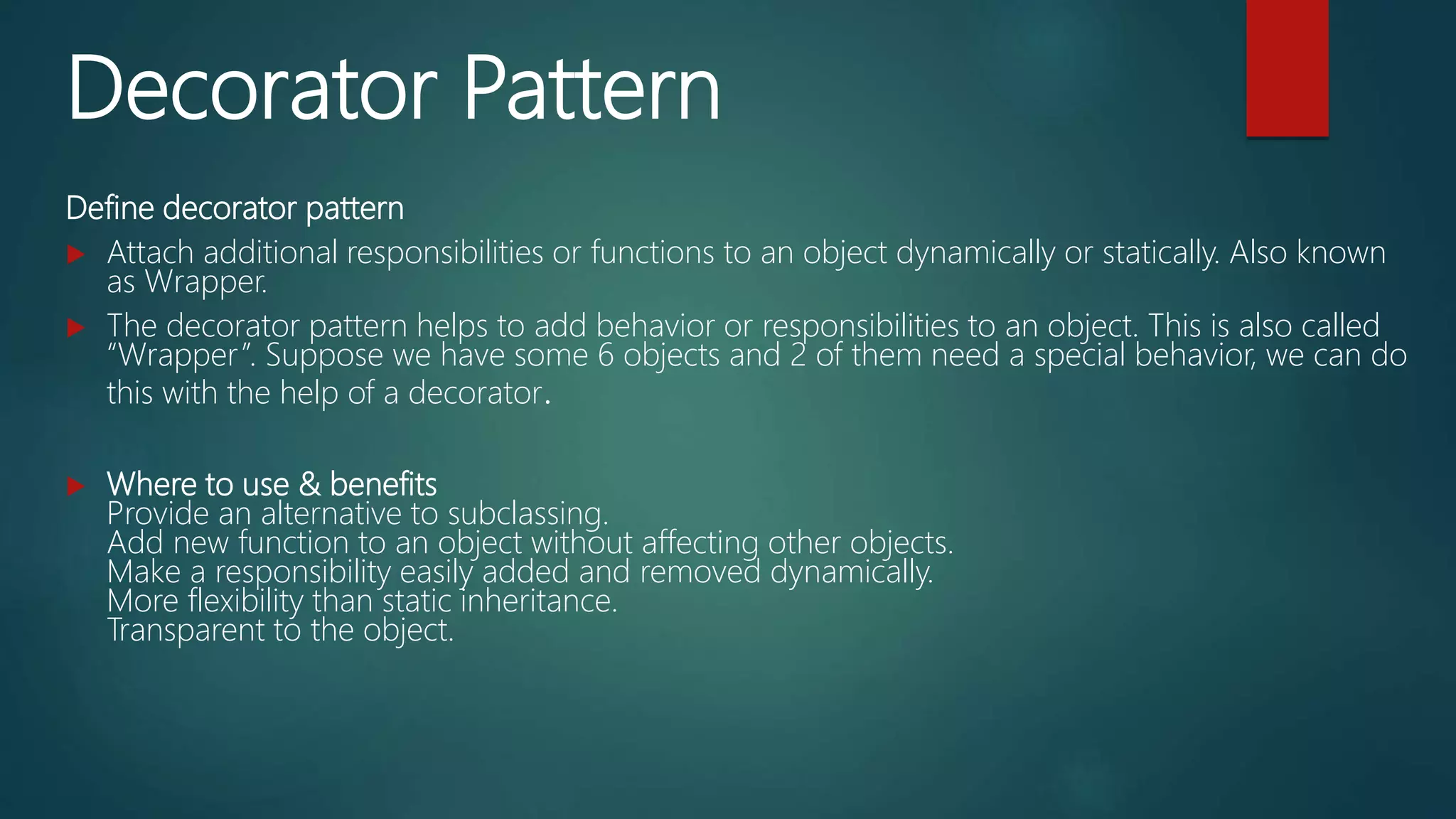
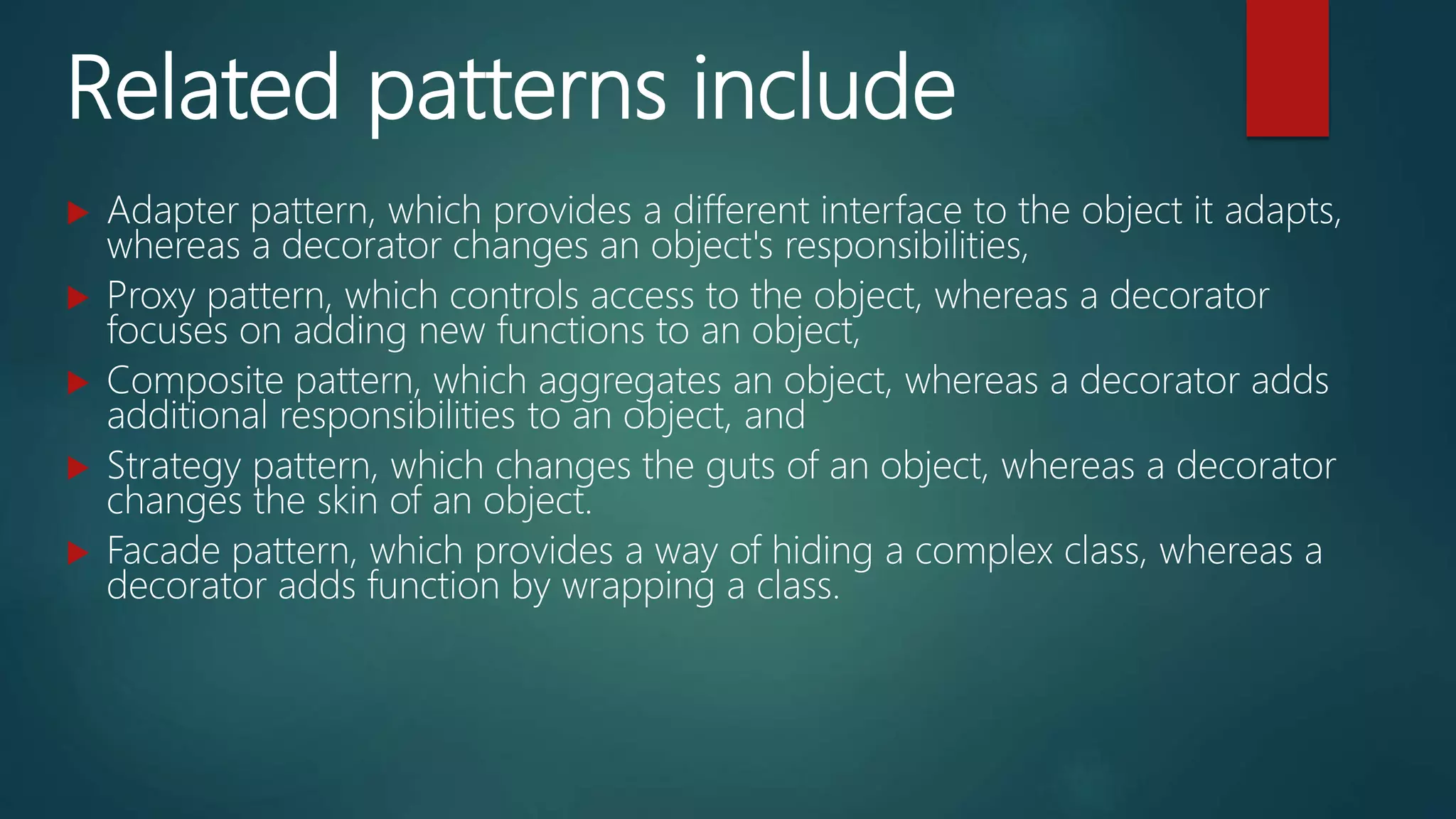
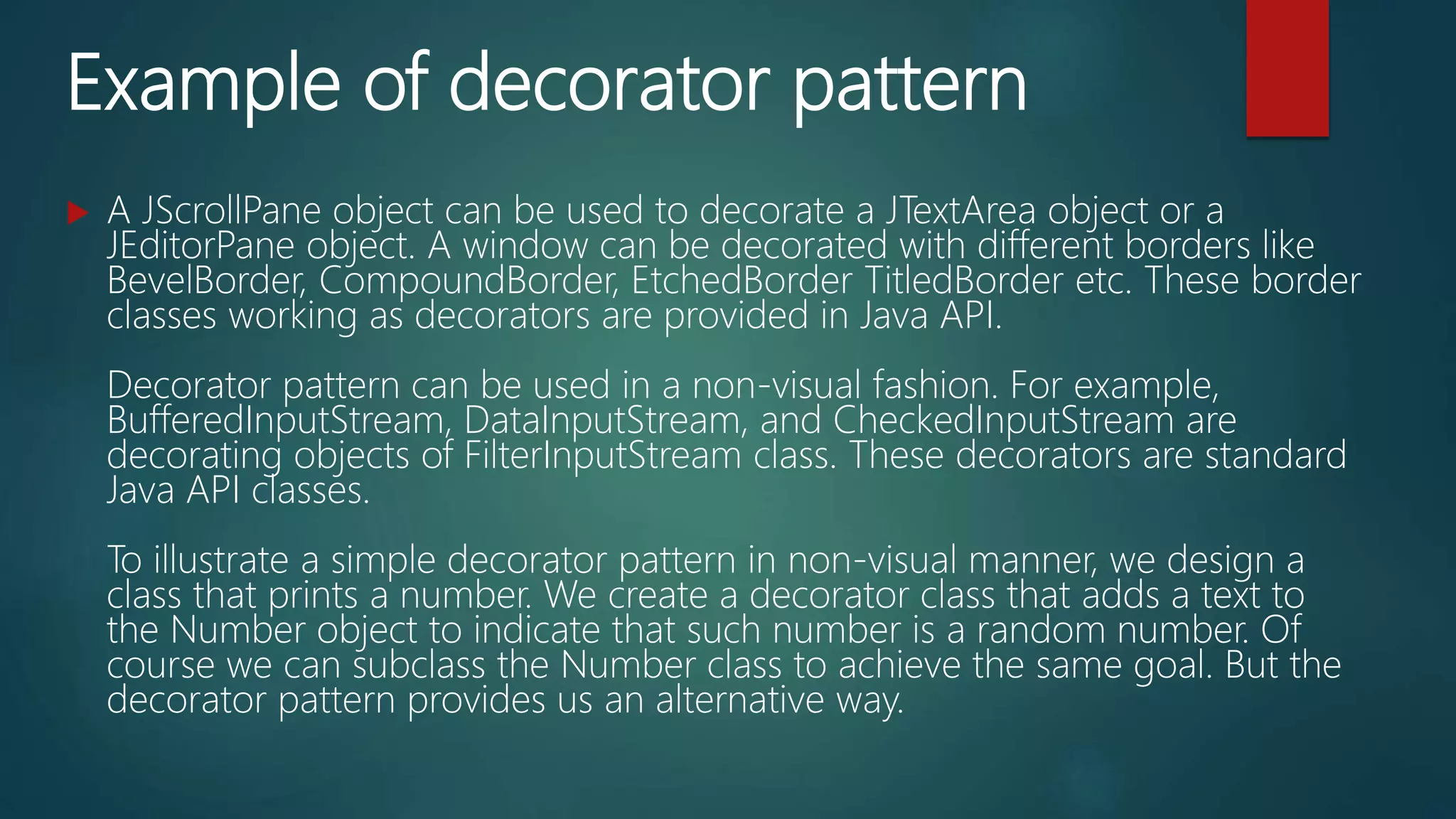
![ import java.util.Random;
class Number {
public void print() {
System.out.println(new Random().nextInt());
}
}
class Decorator {
public Decorator() {
System.out.print("Random number: ");//add a description to the number printed
new Number().print();
}
}
class SubNumber extends Number{
public SubNumber() {
super();
System.out.print("Random number: ");
print();
}
}
class Test {
public static void main(String[] args) {
new Decorator();
new SubNumber();
}
}
Output :
Random number: 145265744
Random number: 145265755](https://image.slidesharecdn.com/structuralpattern3-191124065008/75/Structural-pattern-3-17-2048.jpg)
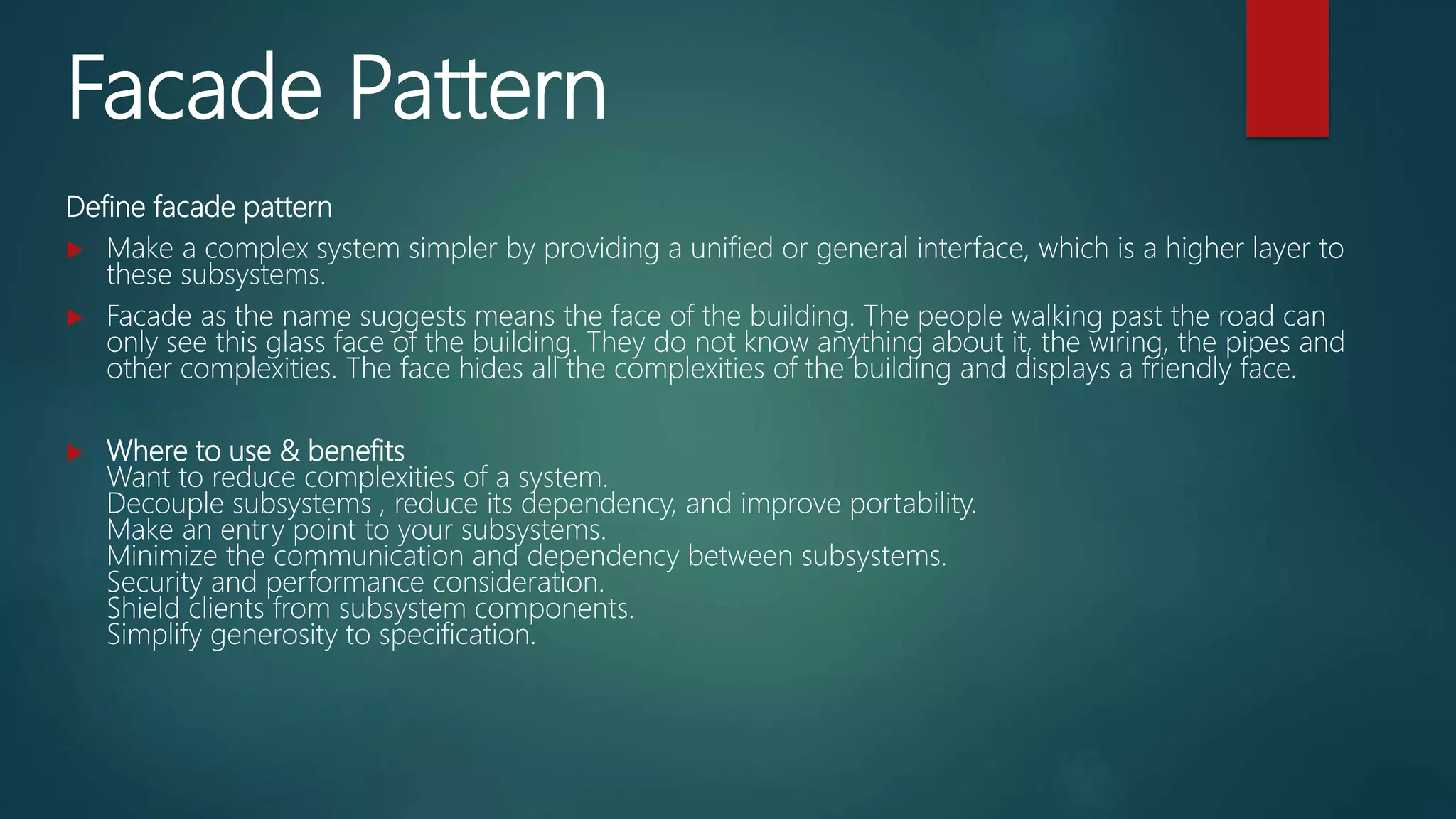
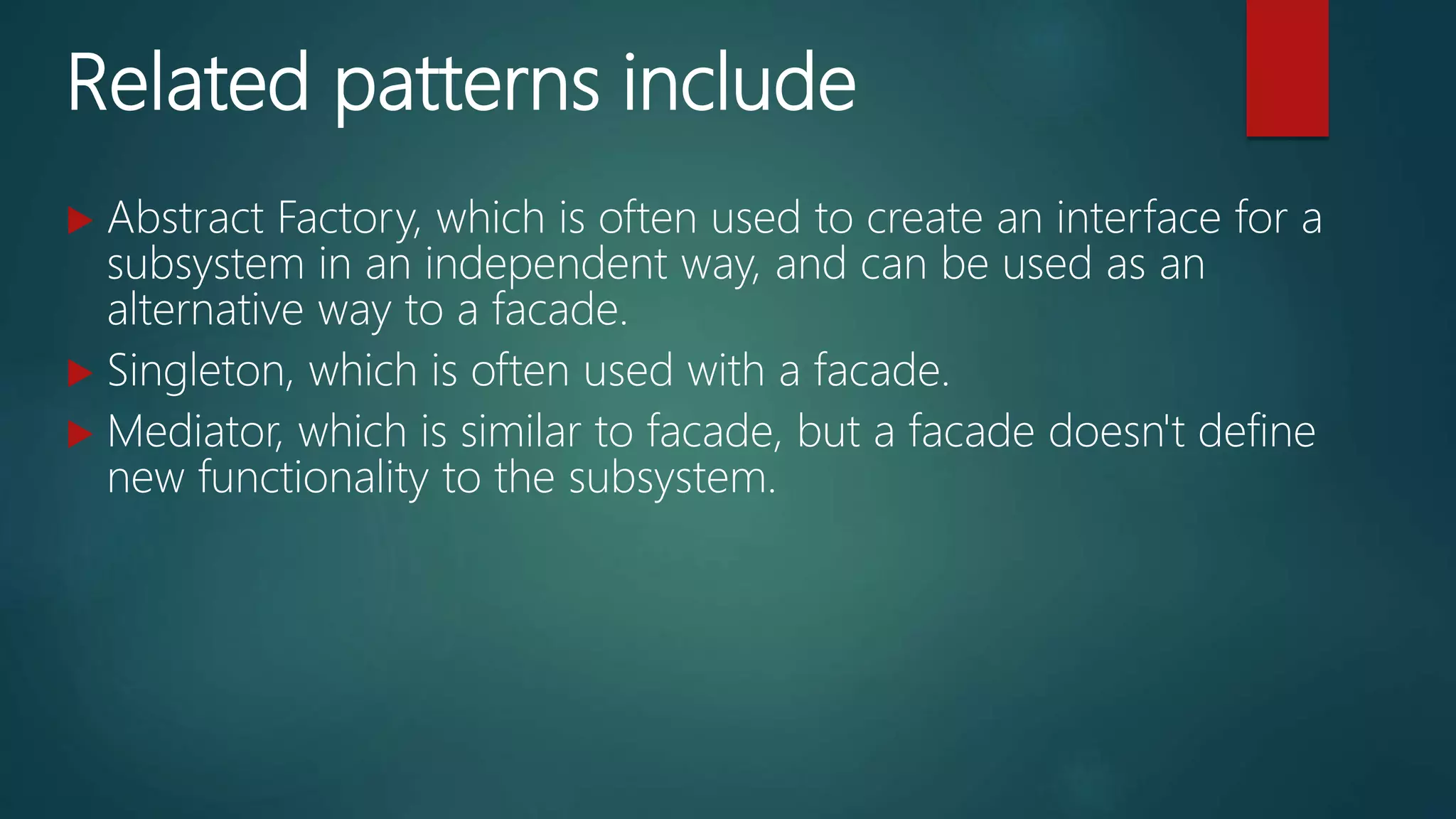
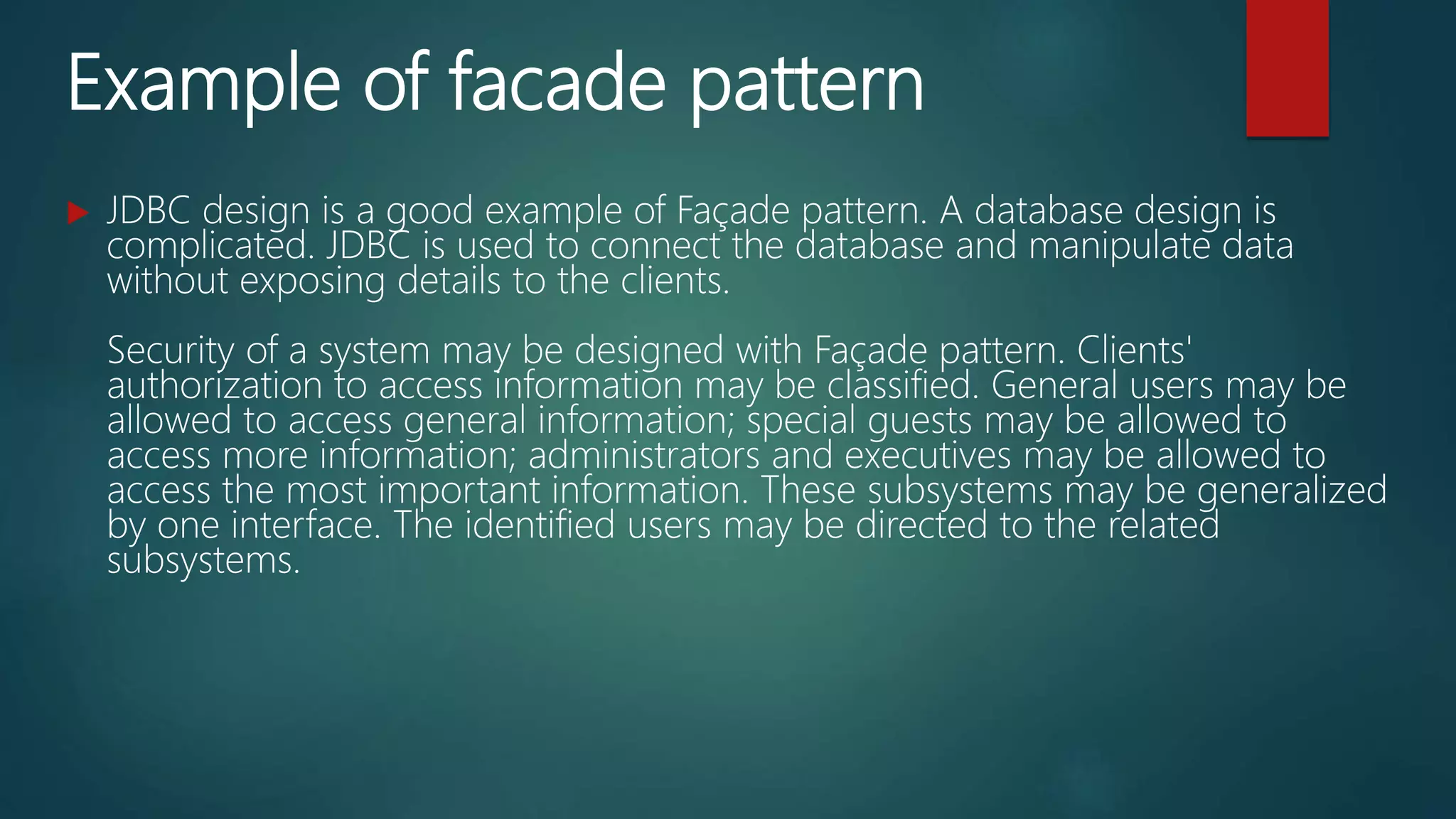

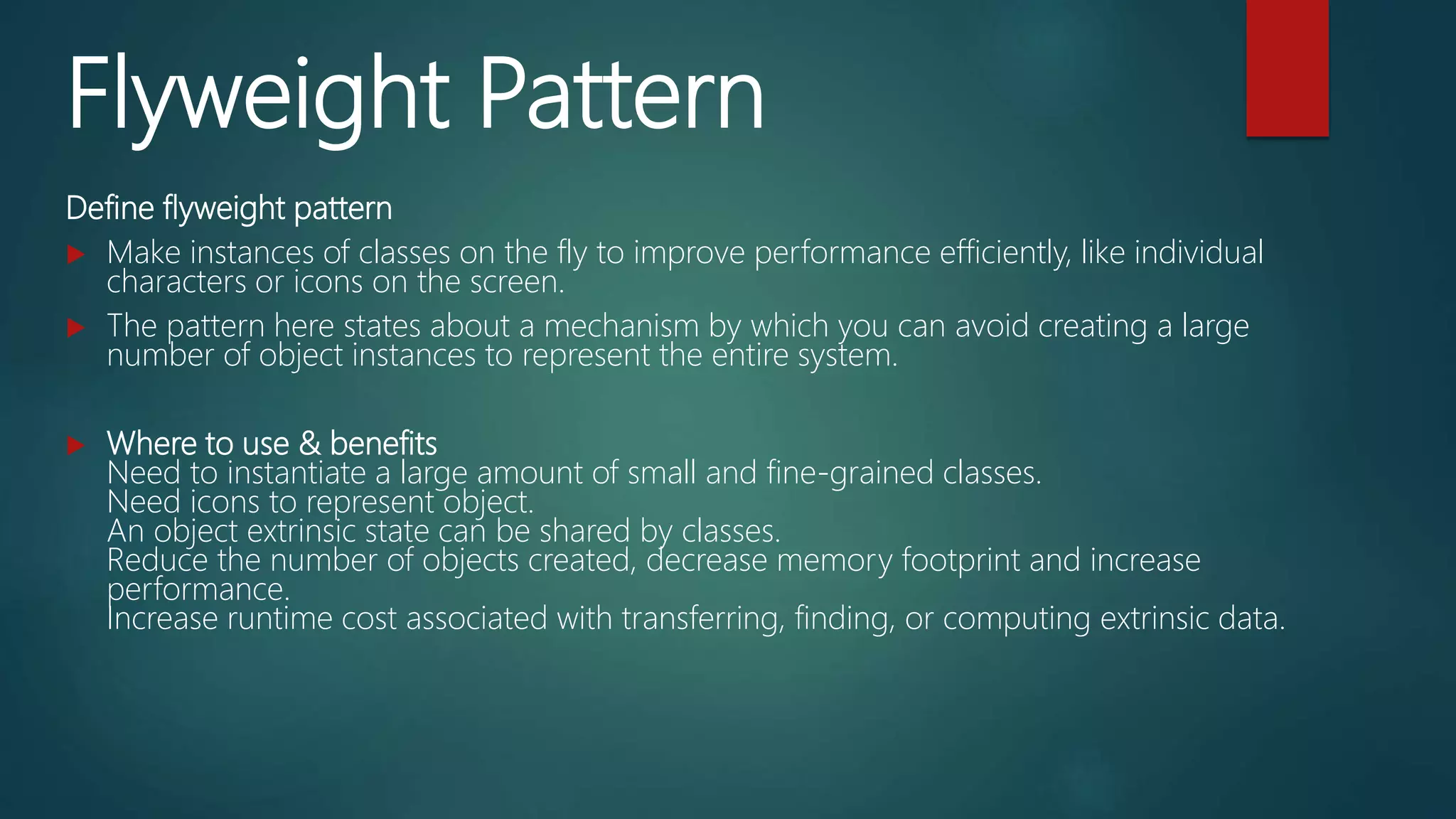
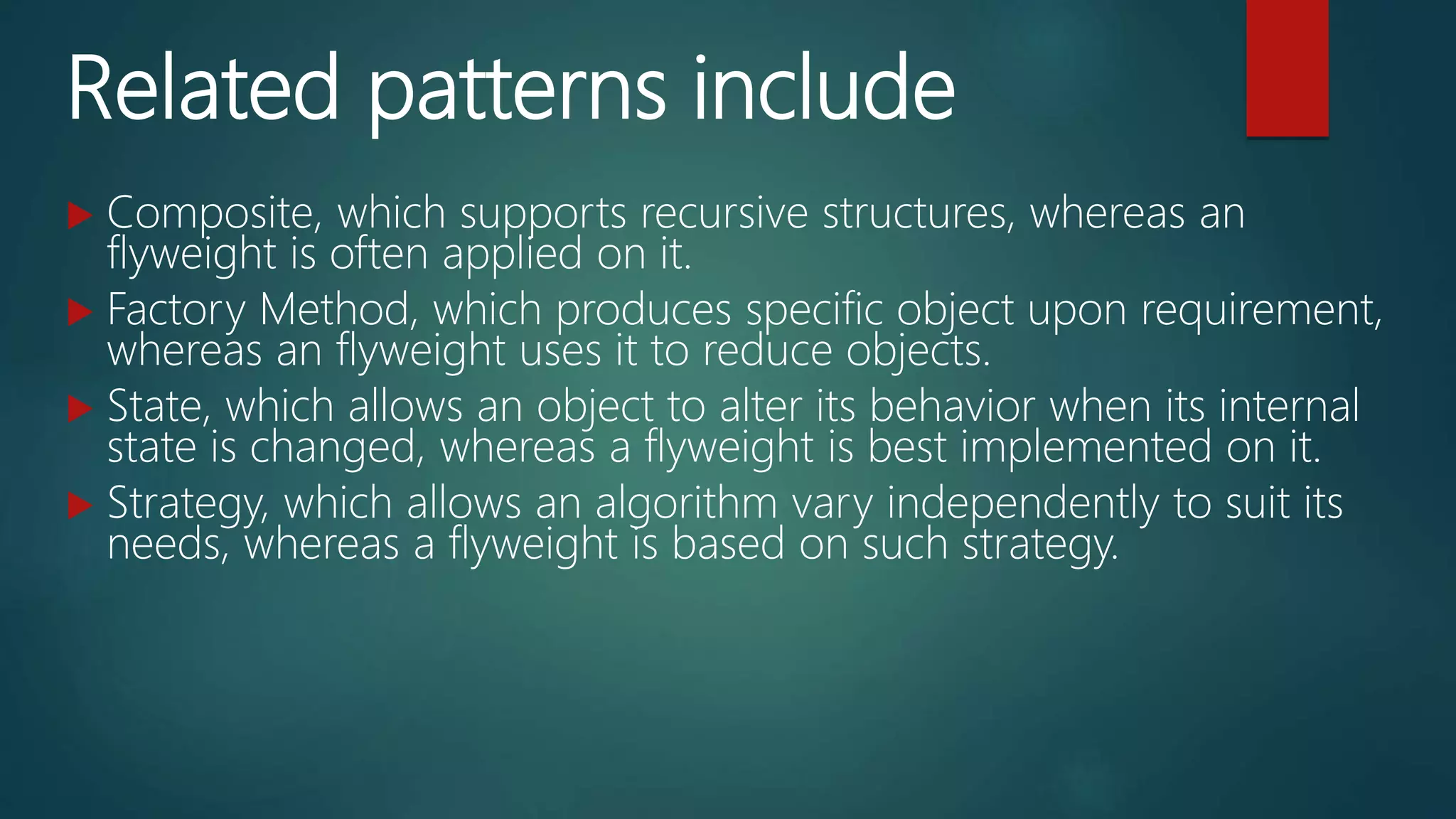
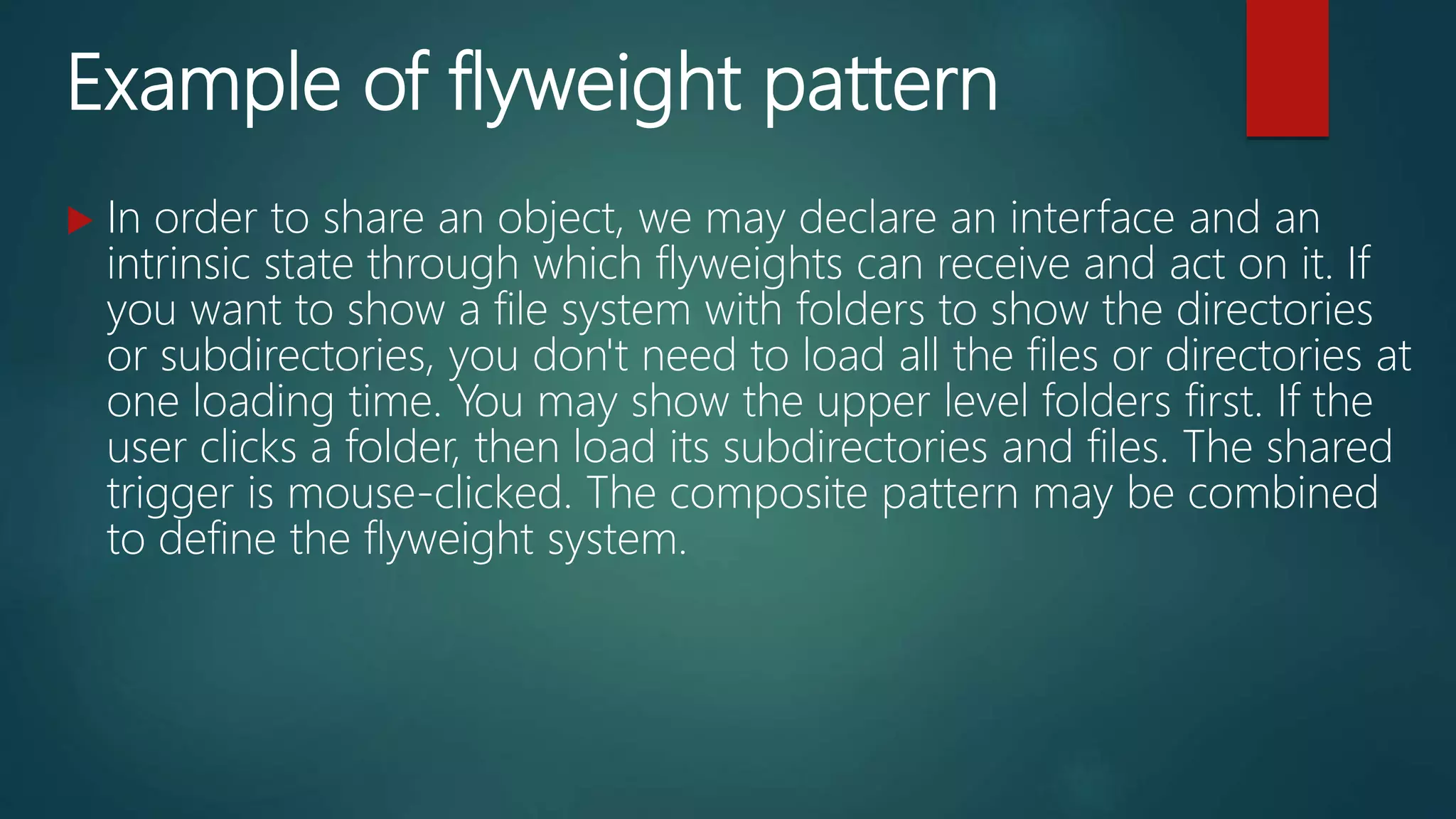
![ class Folder {
void draw(..) {}
}
class FolderFactory {
...
if (selected) {
return aFolder;
else
return aFile;
...
}
...
To show how to use flyweight to reduce object creation, we will make a
program to draw 1000 circles with 6 different colors. Before we customize it
to a flyweight design, it is coded as follows:
import java.awt.*;
import java.awt.Color;
import java.awt.event.*;
import javax.swing.*;
import javax.swing.event.*;
class Test extends JFrame{
private static final Color colors[] = { Color.red, Color.blue,
Color.yellow, Color.orange,
Color.black, Color.white };
private static final int WIDTH_ = 400,
HEIGHT = 400,
NUMBER_OF_CIRCLES = 1000;
public Test() {
Container contentPane = getContentPane();
JButton button = new JButton("Draw Circle");
final JPanel panel = new JPanel();
contentPane.add(panel, BorderLayout.CENTER);
contentPane.add(button, BorderLayout.SOUTH);
setSize(WIDTH,HEIGHT);
setDefaultCloseOperation(JFrame.EXIT_ON_CLOSE);
setVisible(true);
button.addActionListener(new ActionListener() {
public void actionPerformed(ActionEvent event) {
Graphics g = panel.getGraphics();
for(int i=0; i < NUMBER_OF_CIRCLES; ++i) {
g.setColor(getRandomColor());
int r = getRandomR();
g.drawOval(getRandomX(), getRandomY(), r, r);
}
}
});
}
private int getRandomX() {
return (int)(Math.random()*WIDTH );
}
private int getRandomY() {
return (int)(Math.random()*HEIGHT);
}
private int getRandomR() {
return (int)(Math.random()*(HEIGHT/10));
}
private Color getRandomColor() {
return colors[(int)(Math.random()*colors.length)];
}
public static void main(String[] args) {
Test test = new Test();
}
}
Copy, paste above code, and run it to see the functionality.
Output :](https://image.slidesharecdn.com/structuralpattern3-191124065008/75/Structural-pattern-3-25-2048.jpg)
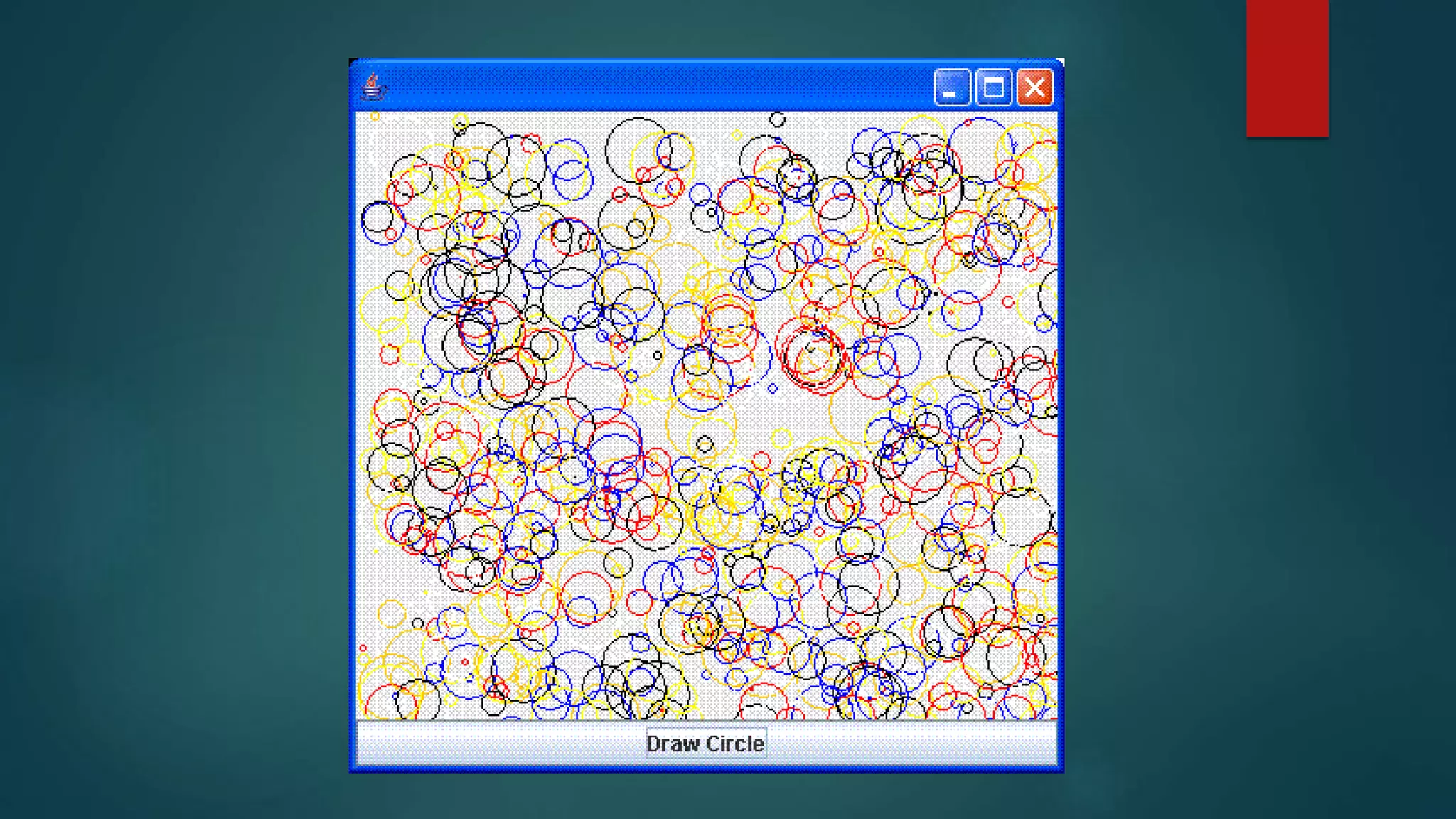
![ Note that the above program doesn't take advantage of reusability of OOP.
We will customize it and make a Circle object, so the Circle object can be
reused.
class Circle {
private Color color;
public Circle(Color color) {
this.color = color;
}
public void draw(Graphics g, int x, int y, int r) {
g.setColor(color);
g.drawOval(x, y, r, r);
}
}
Then we rewrite the program. It is possible for people to rewrite with Circle
object in the following way:
import java.awt.*;
import java.awt.Color;
import java.awt.event.*;
import javax.swing.*;
import javax.swing.event.*;
class Test extends JFrame{
private static final Color colors[] = { Color.red, Color.blue,
Color.yellow, Color.orange,
Color.black, Color.white };
private static final int WIDTH = 400,
HEIGHT = 400,
NUMBER_OF_CIRCLES = 1000;
public Test() {
Container contentPane = getContentPane();
JButton button = new JButton("Draw Circle");
final JPanel panel = new JPanel();
contentPane.add(panel, BorderLayout.CENTER);
contentPane.add(button, BorderLayout.SOUTH);
setSize(WIDTH ,HEIGHT);
setDefaultCloseOperation(JFrame.EXIT_ON_CLOSE);
setVisible(true);
button.addActionListener(new ActionListener() {
public void actionPerformed(ActionEvent event) {
Graphics g = panel.getGraphics();
for(int i=0; i < NUMBER_OF_CIRCLES; ++i) {
Circle circle = new Circle(getRandomColor());
circle.draw(g, getRandomX(), getRandomY(), getRandomR());//1000
object created.
}
}
});
}
private int getRandomX() {
return (int)(Math.random()*WIDTH );
}
private int getRandomY() {
return (int)(Math.random()*HEIGHT);
}
private int getRandomR() {
return (int)(Math.random()*(HEIGHT/10));
}
private Color getRandomColor() {
return colors[(int)(Math.random()*colors.length)];
}
public static void main(String[] args) {
Test test = new Test();
}
}
From the above code, you may note that 1000 circle object has been created.
It is memory consuming.
To improve it, we will create a CircleFactory class to customize it by using
flyweight design pattern. Since we just draw circle with different colors, we
can store color info in a hashmap. If a circle has been drawn, the new circle
will be checked with color. If the circle with the same color has been found in
the hashmap, the circle will share the instance which is picked up from the
hashmap instead of creating a new one. We will reuse the object with
different state, that is to say we will share the instance and draw the circle
with different start position and radius on the fly.
class CircleFactory {
//store color
private static final HashMap circleByColor = new HashMap();
public static Circle getCircle(Color color) {
Circle circle = (Circle)circleByColor.get(color);
if(circle == null) {
circle = new Circle(color);
circleByColor.put(color, circle);
System.out.println("Creating " + color + " circle");//see how many
objects we create on command line
}
return circle;
}
}
So our test program will be coded as follows:
import java.awt.*;
import java.util.HashMap;
import java.awt.Color;
import java.awt.event.*;
import javax.swing.*;
import javax.swing.event.*;](https://image.slidesharecdn.com/structuralpattern3-191124065008/75/Structural-pattern-3-27-2048.jpg)
![ class Test extends JFrame{
private static final Color colors[] = { Color.red, Color.blue,
Color.yellow, Color.orange,
Color.black, Color.white };
private static final int WIDTH = 400,
HEIGHT = 400,
NUMBER_OF_CIRCLES = 1000;
public Test() {
Container contentPane = getContentPane();
JButton button = new JButton("Draw Circle");
final JPanel panel = new JPanel();
contentPane.add(panel, BorderLayout.CENTER);
contentPane.add(button, BorderLayout.SOUTH);
setSize(WIDTH,HEIGHT);
setDefaultCloseOperation(JFrame.EXIT_ON_CLOSE);
setVisible(true);
button.addActionListener(new ActionListener() {
public void actionPerformed(ActionEvent event) {
Graphics g = panel.getGraphics();
for(int i=0; i < NUMBER_OF_CIRCLES; ++i) {
Circle circle = CircleFactory.getCircle(getRandomColor());
circle.draw(g, getRandomX(),
getRandomY(),getRandomR());
//Since we have 6 different colors, we have 6 objects
created.
}
}
});
}
public static void main(String[] args) {
Test test = new Test();
}
private int getRandomX() {
return (int)(Math.random()*WIDTH );
}
private int getRandomY() {
return (int)(Math.random()*HEIGHT);
}
private int getRandomR() {
return (int)(Math.random()*(HEIGHT/10));
}
private Color getRandomColor() {
return colors[(int)(Math.random()*colors.length)];
}
}
class CircleFactory {
private static final HashMap circleByColor = new HashMap();
public static Circle getCircle(Color color) {
Circle circle = (Circle)circleByColor.get(color);
if(circle == null) {
circle = new Circle(color);
circleByColor.put(color, circle);
System.out.println("Creating " + color + " circle");
}
return circle;
}
}
class Circle {
private Color color;
public Circle(Color color) {
this.color = color;
}
public void draw(Graphics g, int x, int y, int r) {
g.setColor(color);
g.drawOval(x, y, r, r);
}
}
Copy, paste above code and run it. You will see the printout from the
command line, that you only have 6 objects created, not 1000 objects
because you only have 6 colors. Such a big reduction of object
creation will improve your program performance dramatically.
Output :
Creating java.awt.Color[r=255,g=0,b=0] circle
Creating java.awt.Color[r=0,g=0,b=0] circle
Creating java.awt.Color[r=255,g=200,b=0] circle
Creating java.awt.Color[r=255,g=255,b=0] circle
Creating java.awt.Color[r=0,g=0,b=255] circle
Creating java.awt.Color[r=255,g=255,b=255] circle](https://image.slidesharecdn.com/structuralpattern3-191124065008/75/Structural-pattern-3-28-2048.jpg)


